Alternative Winter Feeding Strategies for Beef Cattle Management (NM1726, Revised Apr. 2019)
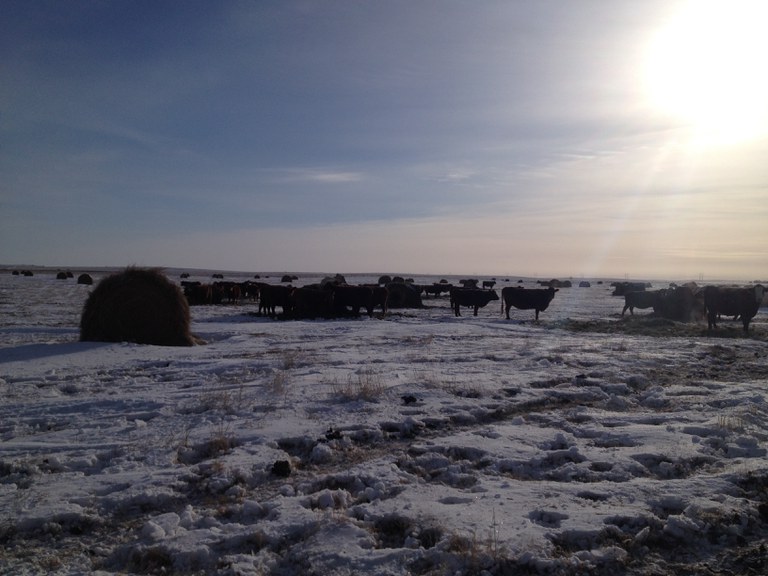
Cows bale grazing in Kidder County, North Dakota. Photo by Mary Keena.
Harsh winter weather conditions in North Dakota often require the confinement of cattle in smaller, sheltered areas.
The size of beef herds has increased through time, while winter feeding areas typically have remained the same size. Concentrated wintering sites, while providing for quick access and care of animals, may increase environmental concerns.
Improperly managed confined-animal facilities pose a pollution risk to surface and ground water. Manure nutrients, such as phosphorus, can reach surface water through runoff and cause oxygen-limiting algae blooms. Nitrogen in manure can pollute ground waters through leaching. Additionally, changes in regulatory guidelines may precipitate a need for changes to traditional winter cattle management practices.
Properly managed wintering sites allow beef producers to be proactive in addressing potential future regulations. Wintering sites selected and managed to maintain consistent vegetative cover will minimize the environmental risk of runoff and seepage when compared with bare ground. Additionally, the cost from the buildup of manure and bedding can be mitigated by utilizing practices that limit confinement.
First, we will define an animal feeding operation (AFO). Drylots are AFOs with total containment of runoff and manure (Figure 1). Lots are usually dirt surfaces that are shaped and sloped to engineering specifications to allow proper drainage and collection of runoff.
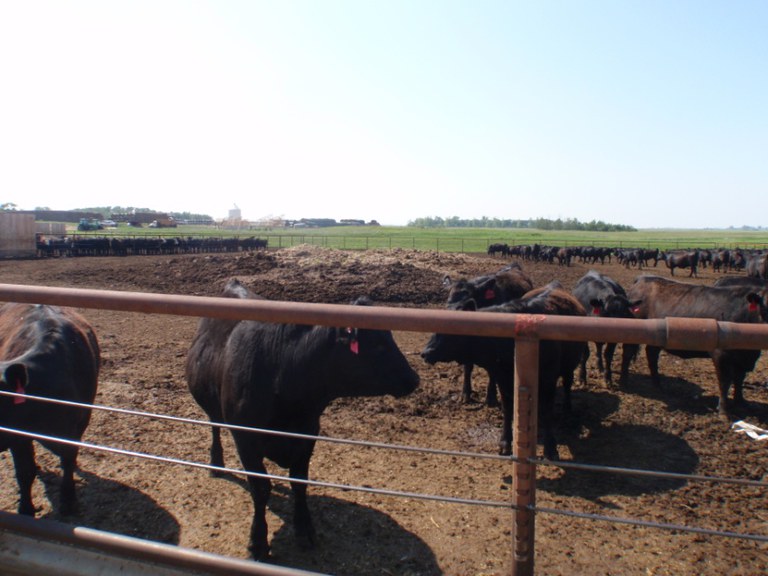
Figure 1. A permitted AFO. Manure is collected from the pen surface and spread on fields as fertilizer. Photo courtesy of the Carrington Research Extension Center.
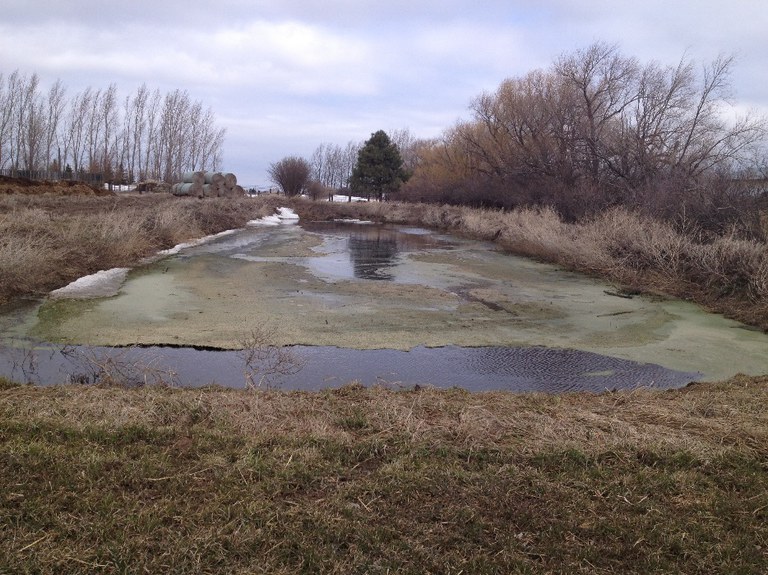
Figure 2. An effluent containment pond. Ponds are designed to hold water for a period of 270 days plus a 24-hour, 25-year rain event, while allowing at least an additional foot of freeboard. Photo courtesy of Mary Keena.
A containment pond is constructed at the base of the lot slope. Containment pond effluent levels are reduced through evaporation or land application as fertilizer. For more information on drylots, consult NDSU Extension publication NM1155, “Beef Feeding Operation Siting and Design Basics.”
Alternative Winter Feeding Strategies
Custom Feeding
Custom livestock feeding gives the producer the flexibility and freedom of wintering his or her cattle somewhere other than his or her home place. Many permitted feedlots throughout North Dakota custom feed cattle.
Advantages
• Producers have flexibility and freedom.
• Producers wintering cattle somewhere other than their home place realize labor savings.
Disadvantages
• Producers have an added economic investment.
Extending the Grazing Season
Grazing periods can be extended by several months through stockpiling and managing forage for late-season use. Forage stockpiling practices include bale grazing, swath and windrowed forage grazing, grazing late-summer-planted cover crops or rested pastures, and utilizing postharvest crop residues.
Extending late-season grazing can distribute manure across a larger area and allow cattle to be maintained on vegetative growth (Figure 3). Allowing limited access and moving cattle frequently is important for uniform manure distribution. Additionally, it can reduce feed waste (Berger and Volesky, 2006). Depending on snow accumulation, a moveable electric fence system can be utilized for consistent grazing across a pasture.
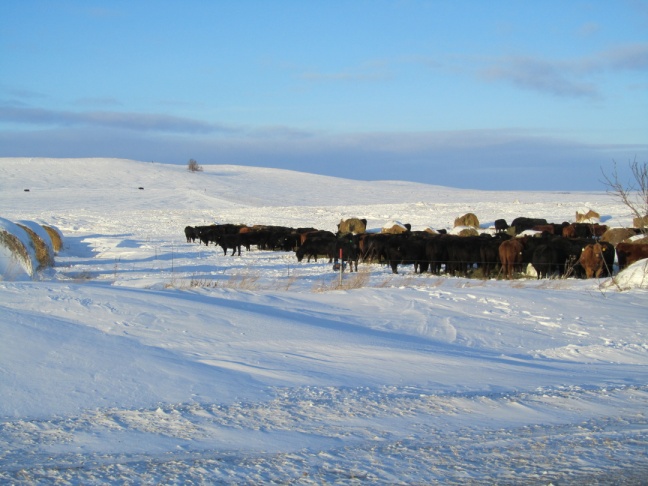
Figure 3. Cattle feeding at a winter site. Photo courtesy of Jason Wirtz, North Dakota Livestock Pollution Prevention Program coordinator
Advantages
• Producers see a winter feeding cost reduction through savings in machinery use, manure handling and fuel.
• Potential improvements occur in pasture productivity through better nutrient cycling in the system. Winter-grazed pastures have shown increased forage protein content and overall yields in comparison with forage fields that have been applied with drylot manure and compost (Jungnitsch, 2008).
Alternative Winter Grazing
Bale Grazing
Bale grazing is an alternative wintering option that involves strategically placing hay bales throughout a field (crop or hay land) and utilizing fencing to allocate bales incrementally to the herd.
Advantages
• More uniform manure distribution (Figure 4) can occur through periodically moving the fenced feeding area for the herd. (Bales typically are placed 20 to 25 feet apart. The removal of twine also has been shown to help animals uniformly consume the bale, minimizing waste.)
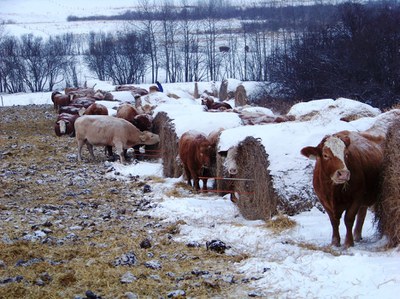 A.
A.
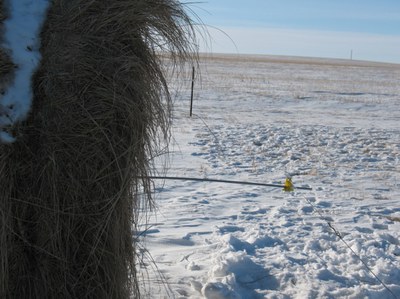 B.
B.
Figure 4. Cattle bale grazing (A). Fiberglass poles are used to secure electric fence to allocate bales for feeding (B). Photos courtesy of Penny Nester, NDSU Extension agent/agriculture and natural resources, Kidder County (A), and Mary Keena, NDSU area extension specialist/livestock environmental management, Carrington Research Extension Center (B).
Swath Grazing
Swath grazing is another alternative wintering option. It involves swathing a summer-grown annual or perennial forage prior to a killing frost. Make sure the swaths are on top of the stubble, narrow and as deep as possible to reduce spoilage of the swathed forage.
Advantages
• Forage utilization is improved by limiting animal access to the amount of forage that can be consumed in a week.
• Frost-tolerant cover crops, such as turnips and cereals, maintain quality as late as December.
Disadvantages
• Cover crops can be covered by snow easily, reducing accessibility, compared with windrowed forage.
Use of Rested Pastures
Pastures that have been rested for most of the growing season can be a good option for early winter dormant-season grazing. Corn and cereal residues also are viable fall and early winter grazing options. Using equipment at harvest that allows for the straw and chaff to be placed in windrows and bunches can increase the ability to use cereal crop residues for late-season grazing.
Disadvantages
• Forage quality can be low and cattle may require supplementation to achieve desired performance.
• Snow accumulation may reduce forage consumption.
Shelter Considerations for Alternative Grazing Strategies
Portable Windbreaks
During extreme cold periods, cattle utilize most of their nutrient intake to meet maintenance requirements, leaving very little extra nutrients available for weight gain. Windbreak fences provide shelter, reducing animal maintenance requirements and allowing producers to maintain or improve animal gains and body conditions (National Research Council, 1981). Portable windbreaks can assist with providing wind and snow protection for animals that are exposed to the elements.
A multitude of materials can be used to construct portable wind fences. Utilizing materials that are durable will increase the longevity of the fences. A durable option would be portable windbreaks constructed on 25-foot lengths of pipe frame with board slots, guardrails or sheets of steel (Figure 5). Paneling of 6 to 10 inches works well.
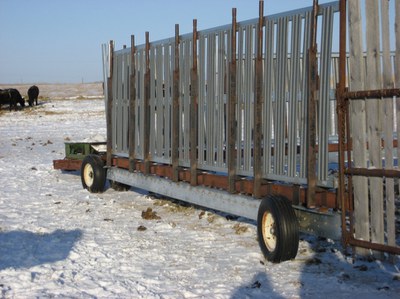 A.
A.
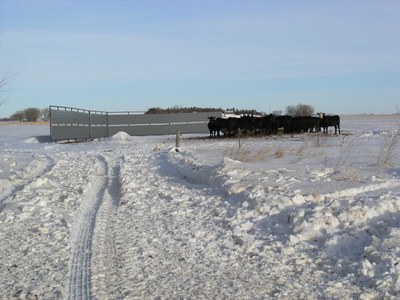 B.
B.
Figure 5. Portable windbreaks. Both portable pull-type windbreak (A) and portable free-standing windbreak (B) can be easily moved and provide shelter for cattle. Photo A courtesy of Penny Nester, NDSU Extension Kidder County agricultural agent, and Photo B courtesy of 319 Watershed Program, Stutsman County.
Windbreaks should be constructed to allow 20 percent of the wind to pass through. The goal is to reduce wind speed but prevent snow drifting. Slot openings greater than 2 inches allow too much wind through. Allowing for 4 to 6 inches of open space at the fence base will promote better drainage and drying.
When selecting a site for fence placement, prevailing winds and drainage should be considered. Other landscape features such as shelter belts, hills and ravines should be factored in as well (Midwest Plan Service, 1986).
As a general rule, 1 linear foot of windbreak protects enough area for one cow when the fence is 6 to 8 horizontal feet. Naturally, windbreaks are a site of animal congregation, so being able to move them periodically helps reduce manure buildup in one area.
Nutrition
Considerations for Alternative Winter Grazing
Alternative grazing systems may or may not have adequate nutrients available to meet the maintenance requirements or improve condition of the beef herd. The type of system employed, growing season conditions, type of animal and stage of production are factors that affect nutrient availability. When utilizing alternative wintering systems, frequently testing feed and monitoring cattle condition will assist with making sure cattle nutrient needs are being met. Depending on the situation, protein or energy and mineral supplements may be needed
Additionally, management of the number of days in the feeding area may need to be adjusted based on stage of gestation, weather and protection available.
Water
Considerations for Alternative Winter Grazing
Cattle require a fresh water source for optimal health and performance. The water content of feedstuffs being consumed and environmental factors play a role in animal water needs. When air temperatures are less than 29 F, cattle require 2 to 3 pounds of water per pound of dry matter intake. Water requirements can double as a result of large temperature changes such as, minus 5 to 30 F (National Research Council, 1981).
Snow can provide water to cattle. Approximately 12 inches of snow can provide 1 inch of water (Brown, 2006). However, some animals may not consume snow readily, and ice crusts often form on snow and limit animal consumption. Water may need to be hauled to cattle or wells may need to be constructed and plumbed into a water delivery system. Many different types of water delivery systems are available (Figure 6).
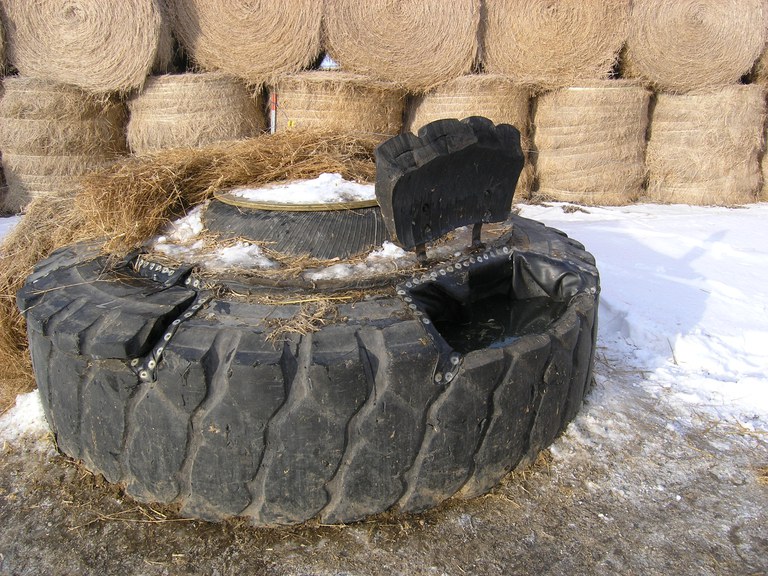
Figure 6. This tire tank is an example of a waterer that may be used at an alternative feeding site. Photo courtesy of 319 Watershed Program, Stutsman County.
Portable waterers powered by solar, wind or a generator can be utilized. Stationary waterers may be heated by electricity, propane or geothermal energy. The wattage of the waterer, and distance and size of electrical lines need to be considered to adequately heat and supply cattle with water. Stray wattage also can cause animals to refuse water sources. Check waterers often to ensure that animals are drinking regularly.
Regardless of the water system, the water trough should be insulated and heated. This ensures that cattle have water and prevents damage to the waterer from expanded ice. The watering system needs to be checked regularly during extremely cold days for ice removal and ensuring the watering system is working correctly.
Winter Site Selection
Ideally, the wintering site should be as far away from a water source (surface water/well) as possible. South-facing slopes allow more direct sunlight, which helps warm cattle and the area.
The grade of the site is also an important consideration. Nearly level slopes (zero to 2 percent) reduce the potential for nutrients to run off and reach bodies of surface water. Moderate slopes (2 to 6 percent) have greater runoff potential, and areas with steep slopes (greater than 12 percent) should be avoided.
Management practices such as buffer strips or leaving crop residue can aid in nutrient filtration and reduce pollution from wintering sites.
Rotating winter-feeding areas from year to year can reduce nutrient loading. Employing feeding locations where nutrient loading is low prevents buildup of excessive soil nutrient levels through time.
Clean-water Diversion
Construction of clean-water diversions prevents runoff from accumulating around the feeding area (Figure 7). This reduces mud, odors and sick cattle.
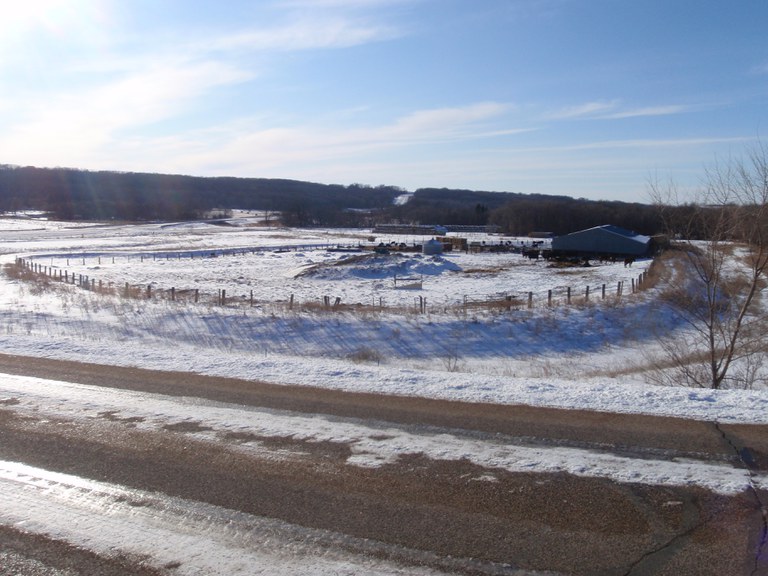
Figure 7. A clean-water diversion constructed at the base of a hill. The diversion prevents contamination of clean upslope runoff with manure in the feeding area. Photo courtesy of Chris Augustin.
Clean-water diversions must be constructed of a relatively impervious material (clay) and be able to divert water from a 25-year, 24-hour rainfall event while maintaining an additional 0.3 feet of freeboard (additional capacity). The minimum width of the top must be 4 feet and have a settlement factor of 10 percent.
The slopes of a clean-water diversion should be shallower than a ratio of 3 horizontal-to-1 vertical. Areas that might endure equipment traffic should have slopes with a ratio of 6 horizontal-to-1 vertical.
The channel grade must be designed to prevent erosion. The maximum acceptable channel velocity is 2 feet per second on sandy soils and 3.5 feet per second for clay dikes with vegetation. The clean-water diversion also must be inspected routinely for erosional wear, ridge height and other factors that might affect the structural integrity (North Dakota Department of Health, 2005).
Summary
Alternative winter-feeding systems can be ranch-efficient and economically feasible, and reduce the chances of environmental issues for a cattle producer. Periodically moving shelter, access to feed and water aids in uniformity of nutrient distribution, alleviating effects of nutrient loading from manure and urine.
Feeding sites should be on gentle south-facing slopes and away from surface or well water. Utilizing the management practices described in this publication can aid the producer in maintaining cattle on locations with consistent vegetative growth, thereby preventing an operation from being classified as an animal feeding operation and concurrently reducing environmental violations.
References
Berger, A.L., and J.D. Volesky. 2006. Windrow grazing. University of Nebraska-Lincoln Extension, Lincoln, Neb.
Brown, L. 2006. Livestock watering factsheet. British Columbia Ministry of Agriculture and Lands. Abbotsford, B.C.
Jungnitsch, P.F. 2008. The effect of cattle winter feeding systems on soil nutrients, forage growth, animal performance, and economics. University of Saskatchewan, Saskatoon, Saskatchewan.
Midwest Plan Service. 1986. Beef housing and equipment handbook. Iowa State University, Ames, Iowa.
National Research Council, 1981. Effect of environment on nutrient requirements of domestic animals. National Academy Press. Washington, D.C.
North Dakota Administrative Code. 2010. Chapter 33-16-03.1 Control of pollution from animal feeding operations. Verfied Jan. 30, 2012.
North Dakota Department of Health. 2005. North Dakota livestock program design manual. North Dakota Department of Health Environmental Health Section Division of Water Quality, Bismarck, N.D.
Regulations and Definitions
In North Dakota, the Department of Health maintains and regulates the guidelines by which beef producers have legal responsibility. All owners/operators are required to make modifications and implement best management practices (BMPs) on their animal facility if it is impacting waters of the state and/or exceeds air quality standards (North Dakota Department of Health, 2005). However, some beef operations that feed cattle are considered animal feeding operations (AFOs), while other operations that feed cattle are not considered AFOs.
According to North Dakota Administrative Code 2010, an AFO is defined as a lot or facility (other than aquatic animal production facility) where the following conditions are met:
Animals have been, are or will be stabled or confined and fed or maintained for a total of 45 days or more in any 12-month period; and crops, vegetation, forage growth or postharvest residues are not sustained in the normal growing season on any portion of the lot or facility.
The key points of the definition are animal confinement for 45 days or more in any 12-month period and vegetation is not sustained. However, if vegetation is maintained on the site, the cattle operation does not meet the AFO definition. Typical rangeland and pasture grasses, forages and annual field crops, even if dormant, are acceptable vegetation. However, weedy species commonly seen in drylot pens (absinthe wormwood, prostrate pigweed and others) are not considered acceptable vegetation.
Changing a few management practices often resolves potential environmental issues. Some examples are winter feeding cattle in a field or the installation of a clean-water diversion at a wintering or calving site. Although costly, permitted drylots are another common and effective way for cattle producers to meet the regulation criteria.
This publication was authored by Mary Keena, Chris Augustin, Karl Rockeman and John Dhuyvetter, retired Extension Specialist, July 2014.

